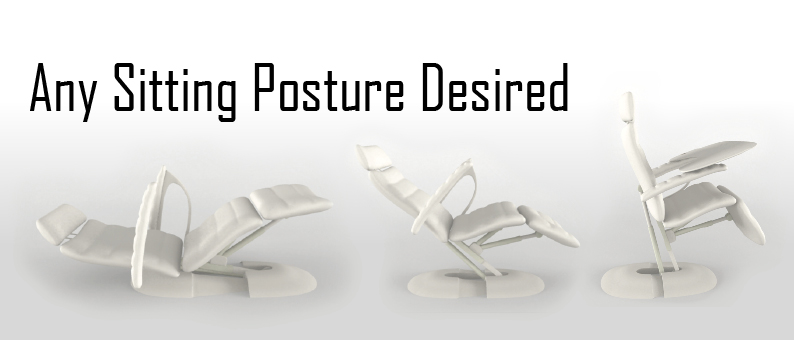|

Adjustable Workstation patent # 20100066132
Patent number: 7922249 Issue date: Apr 12, 2011
Introduction
In the course of a typical day, most people spend their time in 3 basic postures:
a. Standing, walking.
b. Sitting in different positions and locations (in a chair, an armchair, a recliner, sofa, etc.)
c. Lying, usually reclining in a horizontal position (in bed, etc.)
The above-figured workstation enables the user to employ any of these positions (except, of course, walking) while permitting a smooth and effortless transition from one posture/position to another.
The workstation allows the user to choose the desired position from a wide number of available options, and based on such criteria as:
a. Ergonomic or health considerations.
b. The task to be undertaken.
c. The user's comfort or personal preferences.
Technical Details
See attached figure below, or at patent site ,above .
- This workstation is based on an adjustable main shaft (105) able to move through a full 90 degree range from the horizontal-to- a vertical plane.
- Apart from the base section (100), all the workstation components are connected to the main shaft (105)
- All the chair's components can be raised or lowered simultaneously relative to the floor using the "sliding" component (e.g. by employing the sliding profile fitted to the main shaft profile (105)), and by operating the rear piston mechanism (145) which should be electrically powered.)
The workstation can adapt itself to a very broad spectrum of user-activities and tasks. Here are some:
- In the office - as a computer workstation, or replacing a cubicle.
- The w.s can further be used as a stance angle chair-neutral reclined standing.
- At home – as a computer work-desk, watching TV, reading or relaxation.
- For handicapped persons - those who spend most of their time at home or outside.
- Likewise, the workstation can be effortlessly transformed from a reclining/sitting position to a standing one as in a 'lift chair"
- The workstation as presented permits the user to adopt a semi-reclining, back-resting position of (let's say,) a 115-135 degree or any other desired angle.
Assuming that the seat pan is tilted back at an angle ratio of 1:3 relative to the back rest, most ergonomic recommendations regarding correct sitting-posture seem to occur "on their own" with no particular user-effort or special attention. This happens naturally, due to the body's own gravitational factor.
This means that from the user's part, the appliance provides
- greater comfort
- a higher degree of work efficiency
- appreciably reduced employee work-absence
- a feeling of well being
Moreover, in a horizontal lying position, or in a substantially backward incline, with the thighs at 45 deg angle to the horizontal, calves horizontal (or slightly raised) with ankles raised above the level of the heart, the blood flow is appreciably enhanced.
At the same time, the user is in what is termed a posture of "zero-gravity", namely a state of substantially reduced pressure on the spinal column.
From here on recommended reading or watching
More discussion about the problems of sitting up straight ...
"The research project that was presented at the RSNA Meeting in Chicago (U.S.) last week by Dr. W. A. Bashir et al. got enormous press coverage and spread like wildfire over the worldwide web. The study confirmed with the help of a MRI technique that sitting in a slouched forward position or just upright in a 90 degrees position was very unfavourable for the position of the nucleus and the intervertebral disk height.
Of course, leaning back in your chair with full support of backbones and shoulders is more relaxing then any more erect sitting posture.
- Sitting down for extended periods increases the risks of cardiovascular disease, diabetes, depression and obesity, according to American Cancer Society researchers who looked at 123,000 people’s health over 14 years.
Canada occupational safety
Sitting jobs require less muscular effort, but that does not exempt people from the injury risks usually associated with more physically demanding tasks. For example, clerks, electronic assembly-line employees, and data entry operators who work in a sitting position also suffer back pain, muscle tenderness and aches. In fact, reports of varicose veins, stiff necks, and numbness in the legs are more common among seated employees than among those doing heavier tasks.
Prolonged sitting:
· reduces body movement making muscles more likely to pull, cramp or strain when stretched suddenly,
· causes fatigue in the back and neck muscles by slowing the blood supply and puts high tension on the spine, especially in the low back or neck, and
· causes a steady compression on the spinal discs that hinders their nutrition and can contribute to their premature degeneration.
· Is there a "good" sitting position?
For each major joint such as the hips, knees, and elbows, there are ranges within which every healthy person can find comfortable positions. .Varying these positions is the essence of good sitting work. So, a good sitting position is one that allows employees to change their body positions frequently and naturally when they want without being restricted by the work station or job design.
· Perhaps the best description of a "good" position is a set of naturally chosen body positions that fall within an acceptable range. A workstation that allows frequent changes and more mobility allows an employee to have a more natural and healthier work pattern.

Conclusion
The workstation here described will enable the user to change his /her sitting posture throughout the day ,at work or at home, (all the way from deep reclining to stance angle chair), thus improving significantly his / her well- being feeling , efficiency, & health.
I wish to license my patent .
Sincerely,
Rafael Tal Marchand ( inventor)
|